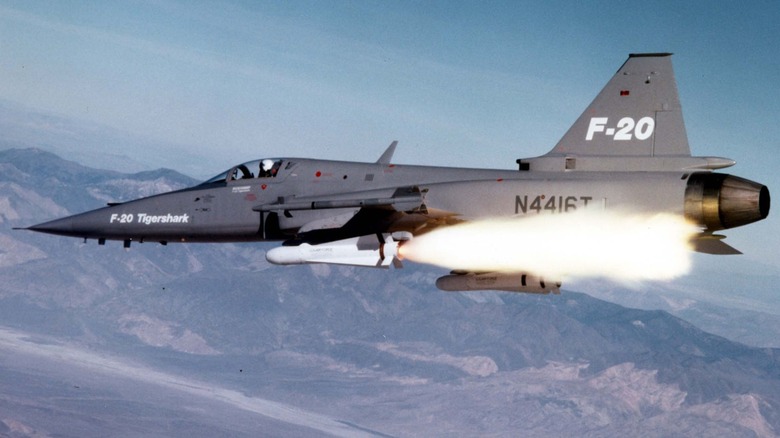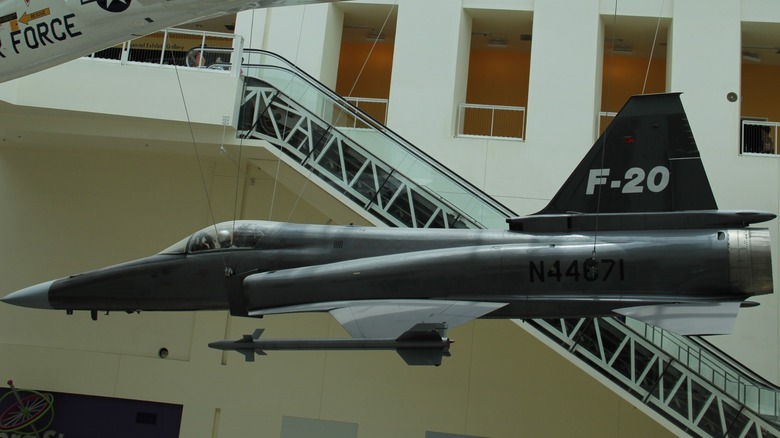All About The F-20 Tigershark: The Fighter Jet That Was Doomed To Fail
When it comes to the United States' most impressive fighter jets, most are familiar with them even if they're not affiliated with the military. That's because aircraft like the stealthiest fighter ever built, the F-22 Raptor, get a lot of press, as do older platforms like the F-16 Fighting Falcon. One fighter jet that most folks have likely never heard of is the F-20 Tigershark, which never made it out of the prototype stage, though three were built.
The F-20 Tigershark originated from the F-X project under President Jimmy Carter's administration, aiming to develop a relatively inexpensive fighter that could challenge the Soviet Union's best aircraft of the day. Ideally, any fighters produced under the program would fall between the F-5E Tiger, which is still in service today, and the ever-evolving F-16A Fighting Falcon in terms of capabilities. F-X aircraft didn't use sensitive technology, primarily relying on off-the-shelf products. The result was the F-20, which boasted impressive capabilities despite lacking more advanced technology.
The F-20 Tigershark was planned for export, so it wouldn't have flown for the U.S. had it been put into full-scale production. But it never did, largely due to the prevailing political climate at the time. While the Cold War-era F-20 boasted impressive capabilities at a low cost, the U.S. eventually relaxed exports of the F-15 and F/A-18, which ultimately ended the F-20 program. The clincher was the deaths of two test pilots, Darrell Cornell and David Barnes, both of whom passed out due to high-G maneuvers.
The F-20 Tigershark brought a lot to the table
The F-20 Tigershark was based on the lightweight F-5 Freedom Fighter, and was made using relatively inexpensive materials to counter the threat of Soviet MiG fighters of the era. It used a single General Electric F404 turbofan engine that produced 17,000 pounds of thrust once the afterburner was engaged. This enabled the F-20 to reach a speed of Mach 2.1 (1,560 mph). It also had a maximum service ceiling of 55,000 feet.
It featured the advanced General Electric AN/APG-67 radar, a cockpit heads-up display, and hands-on throttle and stick controls. It also had excellent visibility, thanks to the large pressurized bubble canopy, which closely mirrored that of the F-16. In terms of weapon systems, the fighter boasted two 20mm M239A2 cannons and could carry up to 8,000 pounds of ordnance. It was also capable of firing the AIM-9 Sidewinder and AIM-7 Sparrow air-to-air missiles, as well as the AGM-65 Maverick air-to-ground missile.
Northrop didn't build the aircraft from an order placed by the U.S. Air Force; instead, the firm constructed it privately. That's one of the reasons the Air Force wasn't interested, though attempts were made to sell it to the service, using Brig. Gen. Charles "Chuck" Yeager to try to sway the brass:
Still, it was President Ronald Reagan's easing of export restrictions that ultimately killed the project. When the F-16 and F/A-18 became available to foreign customers, they lost interest in the F-20. Part of the reason was that the F-20 was not a top-tier fighter, and it lacked fly-by-wire controls.
You can visit the only surviving F-20 in Los Angeles
The operational history of the F-20 Tigershark is a tragic one, marked by two prominent deaths and an incomplete aircraft. While a fourth F-20 was never fully assembled, the three that were completed operated pretty much as advertised. Unfortunately, the fighter's high-G capabilities resulted in two crashes. The first disaster occurred when Northrop pilot David Cornell was demonstrating the F-20 at Suwon Air Base, South Korea.
During his flight, the excessive G-forces caused him to black out, leading to a crash that killed him on impact. Dave Barnes, another test pilot for Northrop, was preparing for the Paris Air Show when the same thing happened: A blackout from excessive G-forces resulted in a deadly crash at Goose Bay, Labrador, Canada. With the prospect of exports already reduced by Reagan's election and policy changes, the crashes sealed the fate of the F-20. While the two that crashed were destroyed, the one remaining aircraft survived and is on permanent display at the California Science Center in Los Angeles.
The F-20 is an interesting aircraft because there was nothing truly wrong with it mechanically or technologically. Had politics not intervened, there's a good chance it would have gone into full-scale production. Today, it serves as a reminder of the complexity of producing a new jet fighter, and while it was an excellent plane, it may have been created at the wrong time.


